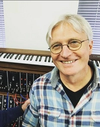




In this installment of Sound Industry History, Max Alper looks at a tool that was pivotal to the democratization of modern music-making: Garageband. Used by prominent musicians like Steve Lacy, Grimes, Justice to Rihanna.
The 21st century removed the most prominent barriers of entry into the world of music technology. Never have we been able to create such professional-quality sound designs and compositions through something as commonplace as a cell phone or tablet device. What would have cost thousands of dollars in studio time and tens of thousands in gear less than three decades ago has become a standard computer capability by default. Society’s listening habits have shifted as a result, now we use our consumer devices to discover and listen to new music that was likely produced on the same type of device.
While we can’t ascribe the entire trajectory of music technology accessibility to a single person or invention, there is one computer music innovator whose work has become synonymous with introducing millions of musicians to music technology. Most of his biggest fans might not even know his name, but his work speaks for itself. He is Dr. Gerhard Lengeling, the Lead Architect and Senior Director of Music Creation Applications at Apple. Most know him by his most popular invention, Garageband, a digital audio workstation (DAW), used by over 50 million musicians worldwide.

(Source)
While formally trained as a physician, Dr. Lengeling made quite the hobby out of music software development and digital signal processing (DSP). During his downtime from medical school at the University of Hamburg in the early 1980s, Gerhard independently designed his first programs for the Commodore64, Atari ST, and Mac II. His innovative MIDI sequencer and digital notation designs ultimately laid the foundation for Emagic, a music technology development company founded by Lengeling in 1992 along with his collaborators Sven Junge and Chris Adam. In 1993, Emagic would release the first version of Logic, known at the time as Notator Logic, a multi-faceted DAW with MIDI, audio, and notational capabilities. This combination of music software caught the eye of many in the pro-audio and computer music industries, as often these composition and production capabilities would require separate applications.

Gerhard Lengelin (Source)

Gerhard Lengeling (left) (Source)
Ten years after Emagic’s founding and five versions of Logic later, Apple purchased the company and brought Lengeling, Junge, and Adam aboard the Cupertino team in 2002. Lengeling’s first order of business was not only to develop the sixth and largest update to Logic yet, but to create a simplified, more accessible version of the Logic engine, similar to that of Final Cut Pro and it’s more accessible version, iMovie. For both Lengeling and Steve Jobs, it was crucial for music-making to play an integral role in the iLife suite, a free collection of creative softwares built into every Mac computer that also included drawing, photo, and video production applications. Thus, Garageband was conceived, eventually announced to the public in January 2004.
The concept of a free music software with an intentionally simple user-interface, built with the hobbyist or beginner in mind, was unheard of at the time of Garageband’s announcement. For many, this represented the democratization of electronic music at its largest, most mainstream scale. And as with any mainstream-ification of a niche creative field, the release of Garageband created much controversy in the pro-audio communities at the time. While some abandoned their Emagic products at the time of Apple’s acquisition and expansion of the company, millions more, myself included, were now instantly drawn into the world of electronic music by simply owning a Mac. The work of Lengeling and his colleagues solidified Apple products as the standard machines for music-making, expanding access to music technology even furthermore in the 2010s with the development of Garageband for iOS, a mobile DAW, or MAW, that is as powerful and professional as it is accessible and quite literally hands-on fun.

(Source)
This edition of Sound History isn’t meant to toot Apple’s horn more than it needs to, but rather to shine a light on one of many unsung heroes of music technology that quite literally helped create many of our careers. How many of us got our first taste of music technology through Garageband and have never looked back since? If I didn’t get an iBook and a MIDI controller as my bar mitzvah present in 2004, I quite literally don’t know what I would be doing with my life right now, and I expect many may have had the same experience. I recently cast a survey of over 100 international musicians ranging from late teens through their early 50s, I wanted to know what their first DAW was. Out of the 30+ softwares mentioned, Garageband was the #1 choice.

La Meme Young Survey
For such a wide demographic covering endless musical possibilities, that ain’t bad, Dr. Lengeling.

